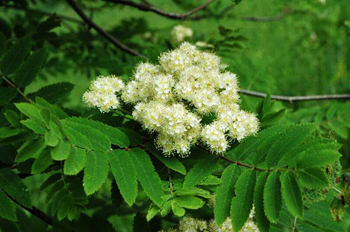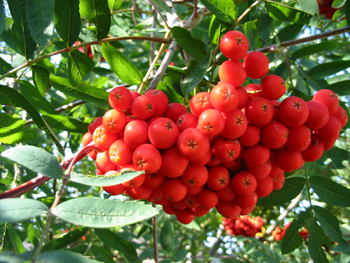Contents:
Common Names | Parts Usually Used | Plant(s) & Culture | Where Found | Medicinal Properties
Legends, Myths and Stories | Uses | Formulas or Dosages | Nutrient Content | Bibliography
Scientific Names

- Sorbus aucuparia L.
- Rose family
Common Names
- European mountain ash
- Mountain ash
- Sorb apple
Parts Usually Used
Fruit
Back to Top

Description of Plant(s) and Culture
Rowan is a deciduous tree or shrub; reaches a height of 50 feet, the stem has close and smooth gray bark. The leaves are alternate and odd-pinnate, with 9-15 oblong-lanceolate, serrate leaflets which are usually finely hairy underneath. Numerous small white flowers appear in compound, terminal, shaggy corymbs during May and June, developing eventually into a berry-like, pea-sized, red pome which ripens in the fall.
Another variety: American mountain ash (S. americana) can also be used in the same way. This shrub or tree grows to 30 feet high and is found from Newfoundland to North Carolina and Michigan.
Back to Top
Where Found
Grows wild in the deciduous forests and mountains of Europe and Asia. Often planted for ornament there and elsewhere.
Back to Top
Medicinal Properties
Aperient, astringent, diuretic
Back to Top
Legends, Myths and Stories
Used to flavor liqueurs and cordials.
Back to Top
Uses
The fresh juice of the fruit is mildly laxative and is useful to soothe inflamed mucous membranes; it makes a good gargle for hoarseness and sore throat. When made into a jam, the juice or fruit becomes astringent and useful for mild cases of diarrhea. One of the sugars contained in the fruit is sometimes given intravenously to reduce pressure in the eyeball in cases of glaucoma. Used also for piles, urinary difficulty, indigestion, gall bladder ailments, angina, coronary problems, blood purifier, appetite stimulant, scurvy, worms, boils, tonsillitis.
Back to Top
Formulas or Dosages
Juice: take 1 tsp. fresh juice at a time, as needed.
Cold extract: soak 1 tsp. dried fruit in 1 cup water for 10 hours. Take 1 cup per day.
Jam: cook fruit with half as much sugar as berries. Take 1 tbsp., 3 to 5 times per day for mild diarrhea.
Back to Top
Nutrient Content
Contains vitamin C
Back to Top
Bibliography
![]() American Folk Medicine
American Folk Medicine, by Clarence Meyer, Meyerbooks, publisher, PO Box 427, Glenwood, Illinois 60425, 1973
![]() Culpeper’s Complete Herbal & English Physician: Updated With 117 Modern Herbs
Culpeper’s Complete Herbal & English Physician: Updated With 117 Modern Herbs, by Nicholas Culpeper, Meyerbooks, publisher, PO Box 427, Glenwood, Illinois 60425, 1990, (reprint of 1814)
![]() Eastern/Central Medicinal Plants
Eastern/Central Medicinal Plants, by Steven Foster and James A. Duke., Houghton Mifflin Company, 215 Park Avenue South, New York, NY 10000
![]() The Herbalist Almanac
The Herbalist Almanac, by Clarence Meyer, Meyerbooks, publisher, PO Box 427, Glenwood, Illinois 60425, copyright 1988, fifth printing, 1994
![]() The Herb Book
The Herb Book, by John Lust, Bantam Books, 666 Fifth Avenue, New York, NY. copyright 1974.
![]() Indian Herbalogy of North America
Indian Herbalogy of North America, by Alma R. Hutchens, Shambala Publications, Inc., Horticultural Hall, 300 Massachusetts Avenue, Boston, Massachusetts 02115, 1973
![]() Indian Uses of Native Plants
Indian Uses of Native Plants, by Edith Van Allen Murphey, Meyerbooks, publisher, PO Box 427, Glenwood, Illinois 60425, copyright 1958, print 1990
![]() The Nature Doctor: A Manual of Traditional and Complementary Medicine
The Nature Doctor: A Manual of Traditional and Complementary Medicine, by Dr. H.C.A. Vogel; Keats Publishing, Inc., 27 Pine Street (Box 876) New Canaan, CT. 06840-0876. Copyright Verlag A. Vogel, Teufen (AR) Switzerland 1952, 1991
 Webster’s New World Medical Dictionary
Webster’s New World Medical Dictionary, New World Dictionaries, 850 Euclid Avenue, Cleveland, Ohio 44114.
